Ŧprevious pageSTUDENT COLLABORATION CATEGORY
Preservation and Progress: Choroni's Productive Traverse
Marisa Bernstein, Student ASLA, and Nicolas Koff, Student Affiliate ASLA
University of Pennsylvania, Philadelphia, PA
faculty advisor: David Gouverneur
Project Statement
The project entails the revitalization of the local productive landscapes in order to sustain the restoration and controlled development of Choroni, a community pushed to its limits by tourism. As a seamless interdisciplinary collaboration between students in landscape architecture and architecture, all scales of design are considered. It indeed addresses economic and environmental problems, preservation of historical and cultural patrimony, education, while emphasizing phenomenological experience of the traditional landscape and architectural typologies of the region.
Project Narrative
"We followed the meandering road through the dense, mountainous cloud-forest, the route, barely large enough to grant our car passage seemed to materialize right out of the fog.
As the misty shroud of the forest finally started to dissipate, the town of Choroni, quiet spectacle of colors and textures, indivisible, appeared.
By day, the scale and fabric of the streets, the adobe posadas, the active harbor, provide an opening onto a rich dynamic past, skillfully disguised under the mask of a sleepy coastal town."
"Past the colonial settlement, through the old cacao plantation and its towering mijaos, a coconut grove reveals our proximity to the "playa grande", as if to prepare us for the majestic, almost overwhelming scenery ahead.
The beach, held preciously within the protective grasp of the forested hills appears sheltered from even time and change themselves."
"At Night, the beautiful idleness of the town gives way to the fervor of the drum circles. Fires light up the city and dance brings it to life. The harbor, locus of production during daytime, becomes ground for socializing and entertainment. Everything is made to give to the senses their full satisfaction. To the glimmer of the ocean and the inextricable sounds of the waves and the traditional drums, there reigns an infinitely favorable sense of excitement, a sensuousness that can only arise from the fine crafting over centuries of a locally adapted way of life.
As the day came, I let my glance wander on the horizon, to the end of memory I could not recall a place of so many contrasts, of entrancing rhythms and intensity, of culture and nature celebrating their unity."
Description of Choroni, travel journal, Day 5
Located on the Northern coast of Venezuela, Choroni is an isolated colonial town of fewer than 5000 people separated from larger settlements by mountains and cloud forests.
Choroni is a multicultural community that was originally relying on fishing and the production of cacao, indigo (aņil) and coconut.
The town is now unfortunately struggling to retain its identity (described in the above passage from our travel journal) and patrimony while it develops into a tourist destination for Venezuelan weekenders. Indeed, during crowded weekends, its population can increase to 40,000.
This uneasy yet unavoidable transition is promoting the growth of informal neighbourhoods encroaching upon the surrounding cloud forest. These new communities are disconnected and reliant on imports from adjacent cities, putting a strain on the vehicular infrastructure of the town, its natural resources and its historical patrimony. For the most part, these new developments are completely disconnected from the local heritage as well as traditional building, planning and cultivating techniques.
Our intervention proposes a rethinking of the transformations taking place within Choroni, one that allows for the simultaneous protection of resources and traditions and the controlled economic and touristic maturation of the region.
The development of a productive promenade entails the revitalization of the local productive landscapes in order to sustain the restoration and controlled development of Choroni. It entails the utilization of vacant land within and around the city to create a meandering promenade of local productive landscapes and additional infrastructural elements that help connect, preserve and ameliorate Choroni's neighbourhoods.
The implementation of this strategy for a productive traverse within Choroni would address the following issues among others:
- Restoring a healthy relationship between the natural and built environments.
- Assessing and controlling the impact of the expanding tourism industry in this small community.
- Implementing a strategy for connecting and integrating formal and informal communities.
- Improving the state of the local infrastructure and create new public spaces to be used for productive, social and educational purposes.
- Exploring ways to design and integrate traditional agricultural systems into the public realm as to reduce the dependency of the town on larger, difficultly accessible communities.
On the level of transportation and communication, the traverse would create lateral pedestrian connections throughout Choroni, the new informal developments and adjacent natural ressources. The riverside portion of the corridors would allow for seamless communication within the town. These new waterside public spaces would reactivate the deteriorating riversides as well as allow for a new water management system that would protect the town, located in an alluvial fan, from flooding.
Main transportation routes would be improved to reduce emphasis on personal vehicles and increase the role of public transportation to the region and within the Choroni area.
New transportation hubs throughout the area help activate zones with economic and cultural potential. These also reduce stress and strain imposed on popular tourist loci.
The phased development of the productive traverse would create the necessary infrastructure and framework for culturally, environmentally and economically sustainable development in the town of Choroni. The implemented natural and built elements would allow for the protection and preservation of the town's patrimony, the promotion of its culture and the controlling of the its further touristic development, insuring that Choroni retains its identity and uniqueness, as well as its extraordinary habitats and ecosystems while it is being subjected to unavoidable changes.
Additional Project Credits
First of all, many thanks to David Gouverneur for all his kindness, help and support. This project would not have come to fruition as successfully without his assistance and dedication.
We would secondly like to thank the following people for giving us their feedback along the way as jury members during critiques: Lucinda Sanders, Oscar Grauer, Laurie Olin, James Corner and Trevor Lee.
We would also like to thank Maria Gabriela Diez and her family for generously welcoming us into her native country as well as leading and guiding us to Choroni.
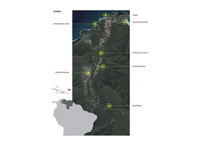
Context (Photo: Marisa Bernstein and Nicolas Koff)
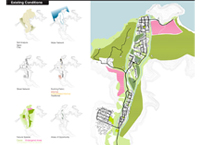
Existing Conditions and Problems:
- Analysis of site conditions including soil, hydrology, building typologies, transportation systems, natural areas, vacant land, endangered areas.
- Analysis of economic and social problems such as tourism, political situation and development
- Study of current building methods (informal construction)
(Photo: Marisa Bernstein and Nicolas Koff)
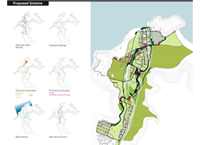
Proposed Scheme and Solutions:
- Analysis of site modifications, road optimization, hydrological systems, reactivation of productive land, educational and cultural as well as production facilities.
- Analysis of communicational strategies as well as areas dedicated to touristic activity.
- Study of benefits of traditional building methods and materials as well as their adaptation to contemporary needs. (Photo: Marisa Bernstein and Nicolas Koff)
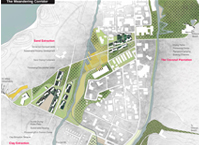
The Meandering Corridor (Photo: Marisa Bernstein and Nicolas Koff)
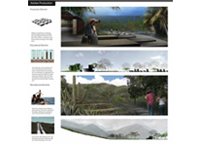
Adobe Production (Photo: Marisa Bernstein and Nicolas Koff)
"A big vision that is well thought through and integrated. The design is strong and the collaboration appears seamless and well-balanced. Good practice for the real world!"
— 2009 Student Awards Jury
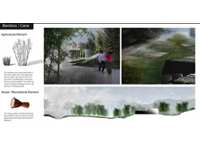
Bamboo/Cane (Photo: Marisa Bernstein and Nicolas Koff)
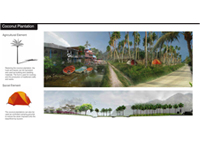
Coconut Plantation (Photo: Marisa Bernstein and Nicolas Koff)
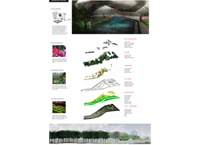
Botanical Garden (Photo: Marisa Bernstein and Nicolas Koff)

Bloom Schedule (Photo: Marisa Bernstein and Nicolas Koff)
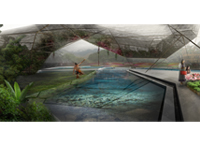
View of the Botanical Garden (Photo: Marisa Bernstein and Nicolas Koff)



